In Michigan’s expansive skies, eight distinct hawk species soar, each contributing to the state’s rich avian diversity.
From the urban outskirts to the untouched wilderness, these raptors navigate varied landscapes, embodying adaptability and predatory prowess.
Among them, the Red-Shouldered Hawk, Sharp-Shinned Hawk, Broad-Winged Hawk, Northern Harrier, Red-Tailed Hawk, Cooper’s Hawk, Rough-legged Hawk, and Northern Goshawk weave a narrative of survival, migration, and ecological impact.
This array of hawks showcases a captivating spectrum of sizes, behaviors, and habitats, painting a vibrant portrait of avian life in the Great Lakes State.
Join us in exploring the nuanced world of these eight remarkable hawk species, discovering their unique characteristics and the pivotal roles they play in Michigan’s ecosystems. Stay sharp.
Common Characteristics of Hawks in Michigan
Hawks in Michigan share several common characteristics that define their presence and behavior in the state’s diverse ecosystems.
These traits contribute to their adaptability and success as predators in various habitats. Here are some common characteristics of hawks in Michigan:
Adaptability
Hawks in Michigan exhibit remarkable adaptability to various environments, from dense woodlands and open fields to urban and suburban areas. This adaptability allows them to thrive in diverse landscapes across the state.
Keen Eyesight
Hawks are renowned for their exceptional eyesight, a crucial adaptation for hunting.
Their keen vision enables them to spot prey from great distances, whether it be small mammals scurrying through the underbrush or birds soaring in the sky.
Powerful Beaks and Talons
H hawks are formidable predators equipped with strong, curved beaks and sharp talons. These tools allow them to capture and consume a variety of prey efficiently, including small mammals, birds, and reptiles.
Migratory Behavior
Some hawk species in Michigan, such as the Broad-Winged Hawk and Rough-legged Hawk, exhibit migratory behavior.
They travel impressive distances during seasonal migrations, contributing to the dynamic birdwatching opportunities in the state.
Territorial Nature
Hawks are territorial birds, defending their nesting sites and hunting grounds.
This territorial behavior ensures a stable food supply for raising their young and contributes to establishing distinct breeding territories across Michigan.
Courtship Displays
During the breeding season, hawks engage in elaborate courtship displays.
These displays often involve aerial acrobatics, soaring flights, and vocalizations, showcasing the birds’ agility and communication skills as they pair up for reproduction.
Nesting in Trees
Hawks typically construct nests in trees, utilizing branches and twigs to create sturdy structures.
The choice of nesting sites varies among species, but the elevated locations offer strategic vantage points for hunting and protecting their young.
Stealthy Hunting Techniques
Hawks are adept hunters, utilizing a combination of stealth and speed to capture their prey. Whether perched high in a tree or soaring through the sky, they employ strategic approaches to surprise and catch their quarry.
8 Hawks in Michigan
Get into the diverse hawks gracing Michigan’s skies. Each species brings a unique flair to the state’s avian tapestry, from the agile Cooper’s Hawk to the winter-visiting Rough-legged Hawk.
Join us as we delve into the characteristics and captivating lifestyles of the Cooper’s Hawk, Rough-legged Hawk, and Northern Goshawk, uncovering their roles in Michigan’s natural balance.
1. Red-Shouldered Hawk
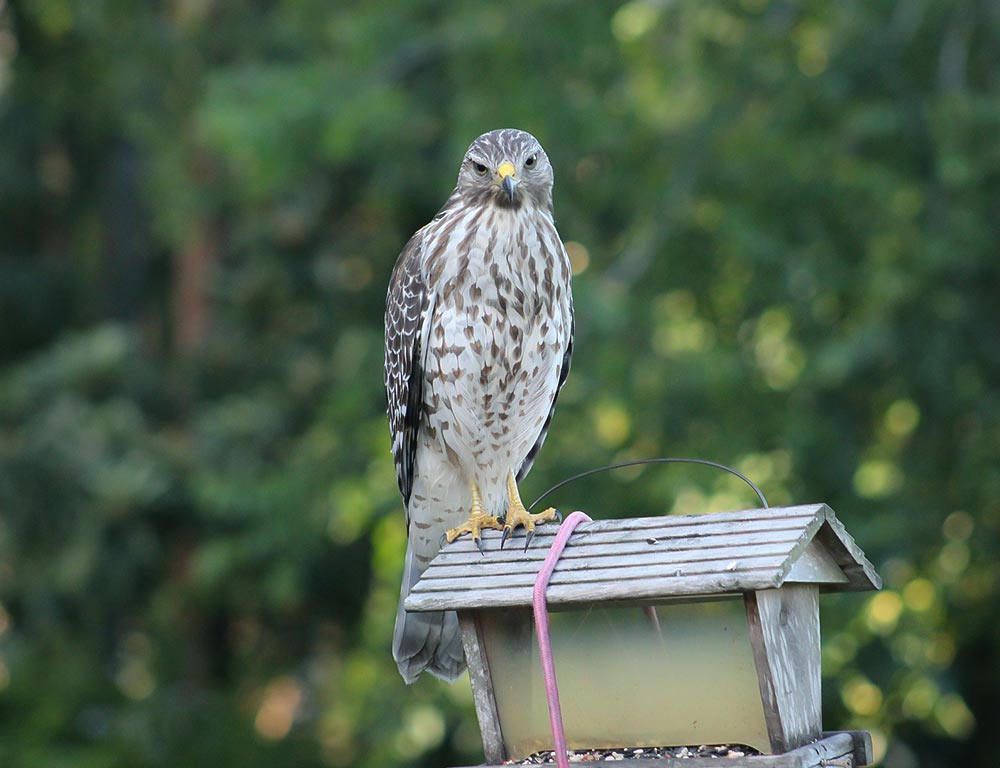
- Scientific name: Buteo lineatus
- Life span: 10-15 years
- Size: 17-24 inches
- Weight: 1-2 pounds
- Food: A carnivorous diet includes small mammals, reptiles, amphibians, and insects
- Wingspan: 37-43 inches
- Status: Generally stable, although local populations may face threats
The Red-Shouldered Hawk is a medium-sized raptor found in the woodlands of Michigan. Recognized by its striking reddish-brown shoulders, this hawk has a lifespan of 10-15 years.
It measures between 17-24 inches and weighs approximately 1-2 pounds. Its wingspan, ranging from 37-43 inches, has a distinct call that echoes through its wooded habitat.
Red-Shouldered Hawks are skilled hunters, preying on small mammals, reptiles, amphibians, and insects. Their status is generally stable, but local populations may face threats due to habitat loss and human activity.
These hawks are known for their elaborate courtship displays, including soaring flights and loud calls, contributing to their fascinating lifestyle in the Michigan woodlands.
2. Sharp-Shinned Hawk
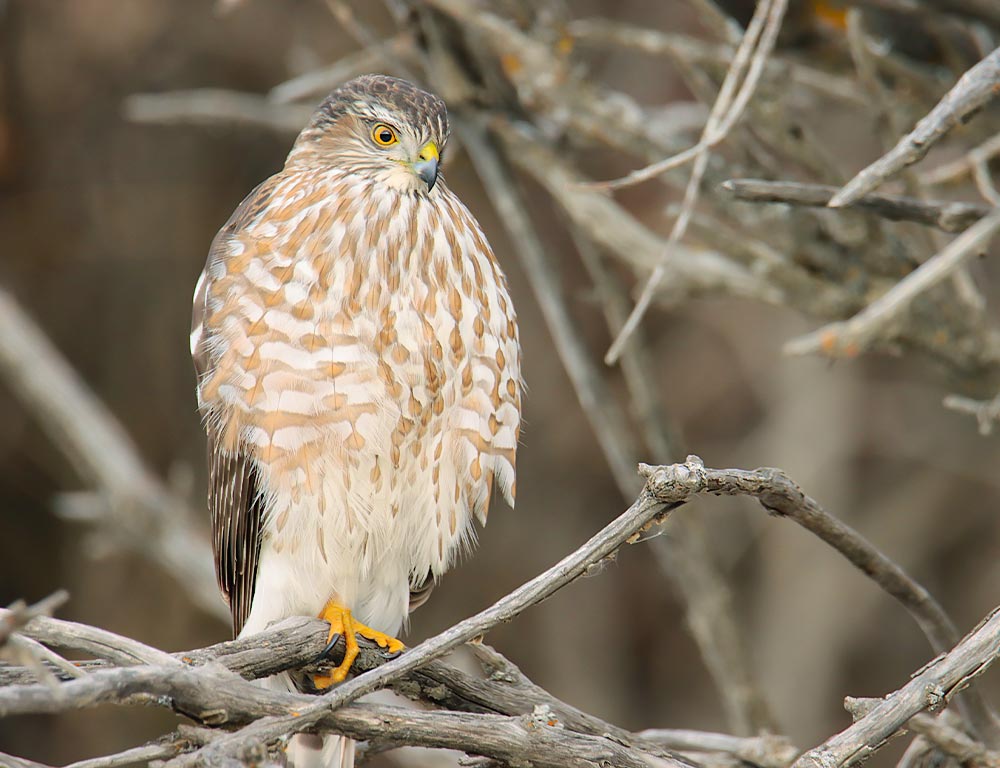
- Scientific name: Accipiter striatus
- Life span: 6-12 years
- Size: 9-13 inches
- Weight: 3-8 ounces
- Food: Primarily birds, occasionally small mammals
- Wingspan: 16-22 inches
- Status: Common and widespread
The Sharp-Shinned Hawk, a small but agile bird of prey, inhabits Michigan with a lifespan of 6-12 years. Measuring 9-13 inches and weighing 3-8 ounces, it has a wingspan ranging from 16-22 inches.
Known for its distinctive long tail and short wings, the Sharp-Shinned Hawk is a bird hunter, primarily preying on other birds with occasional forays into catching small mammals.
This species is common and widespread, adapting to various habitats, including suburban areas. Its swift and dexterous flight makes it a skilled hunter in dense woodlands and open spaces alike.
3. Broad-Winged Hawk
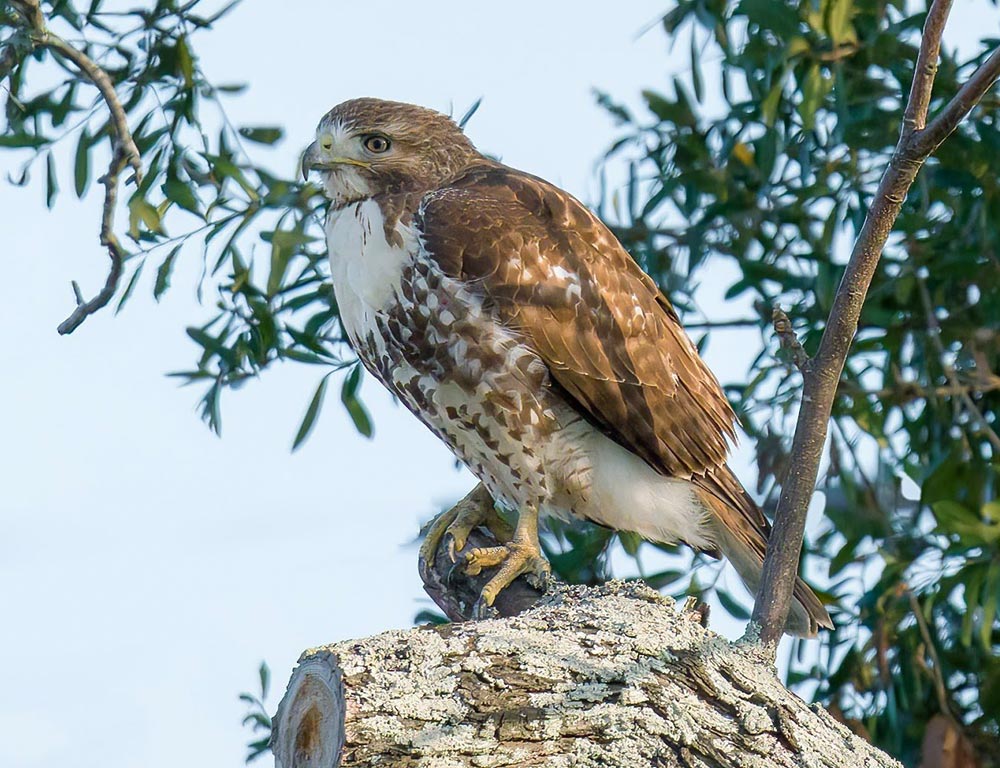
- Scientific name: Buteo platypterus
- Life span: 4-5 years
- Size: 13-17 inches
- Weight: 9-20 ounces
- Food: Small mammals, reptiles, amphibians
- Wingspan: 32-39 inches
- Status: Generally stable, with some regional declines
The Broad-Winged Hawk, with a 4-5 year lifespan, is a medium-sized hawk found in Michigan. Measuring 13-17 inches and weighing 9-20 ounces, it has a wingspan ranging from 32-39 inches.
This species primarily feeds on small mammals, reptiles, and amphibians. Despite being generally stable, some regional populations may decline due to habitat loss and environmental changes.
Broad-winged hawks are known for their migratory behavior, forming large flocks during migration.
They exhibit a unique lifestyle, utilizing updrafts and thermals for efficient long-distance flights, making them an intriguing part of Michigan’s avian landscape.
4. Northern Harrier
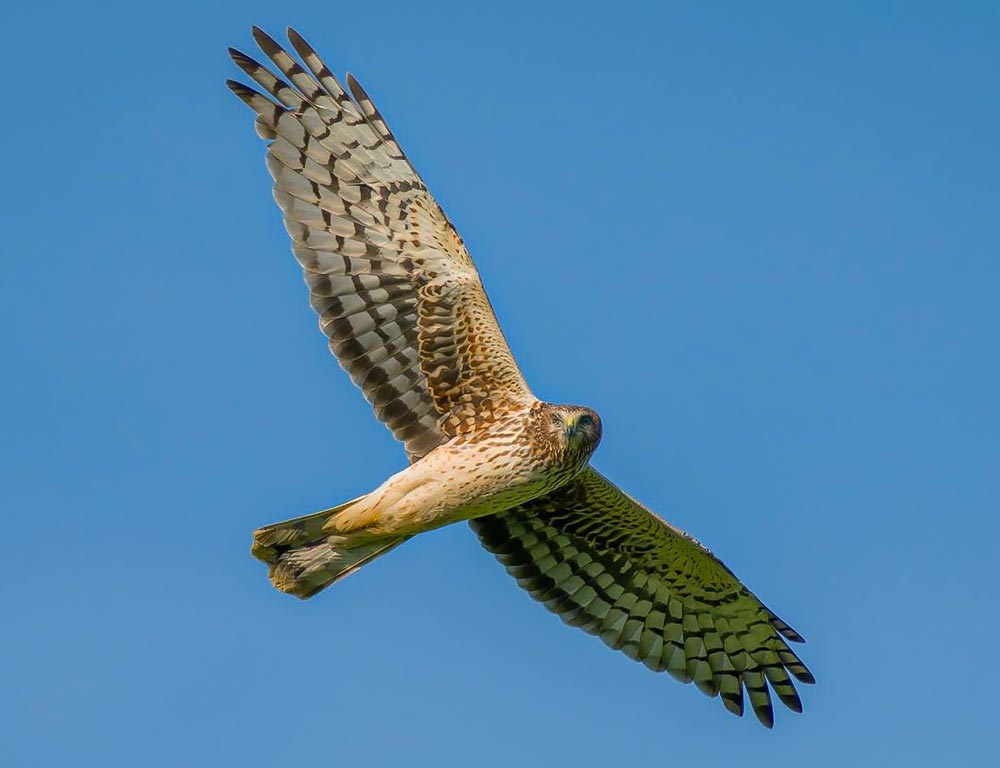
- Scientific name: Circus hudsonius
- Life span: 5-10 years
- Size: 18-24 inches
- Weight: 10-26 ounces
- Food: Small mammals, birds, reptiles, and insects
- Wingspan: 40-48 inches
- Status: Generally stable, but some populations face threats
The Northern Harrier, a distinctive hawk with its owl-like facial disk, inhabits various habitats in Michigan. With a 5-10 years lifespan, it measures between 18-24 inches and weighs 10-26 ounces.
Its wingspan ranges from 40-48 inches, allowing it to glide low over open fields and marshes gracefully. Northern Harriers primarily feed on small mammals, birds, reptiles, and insects.
Known for their hovering behavior while hunting, these hawks have a generally stable status, although some populations may face threats due to habitat loss and agricultural practices.
Their unique hunting style and adaptability to diverse landscapes contribute to the fascinating lifestyle of Northern Harriers in Michigan.
5. Red-Tailed Hawk
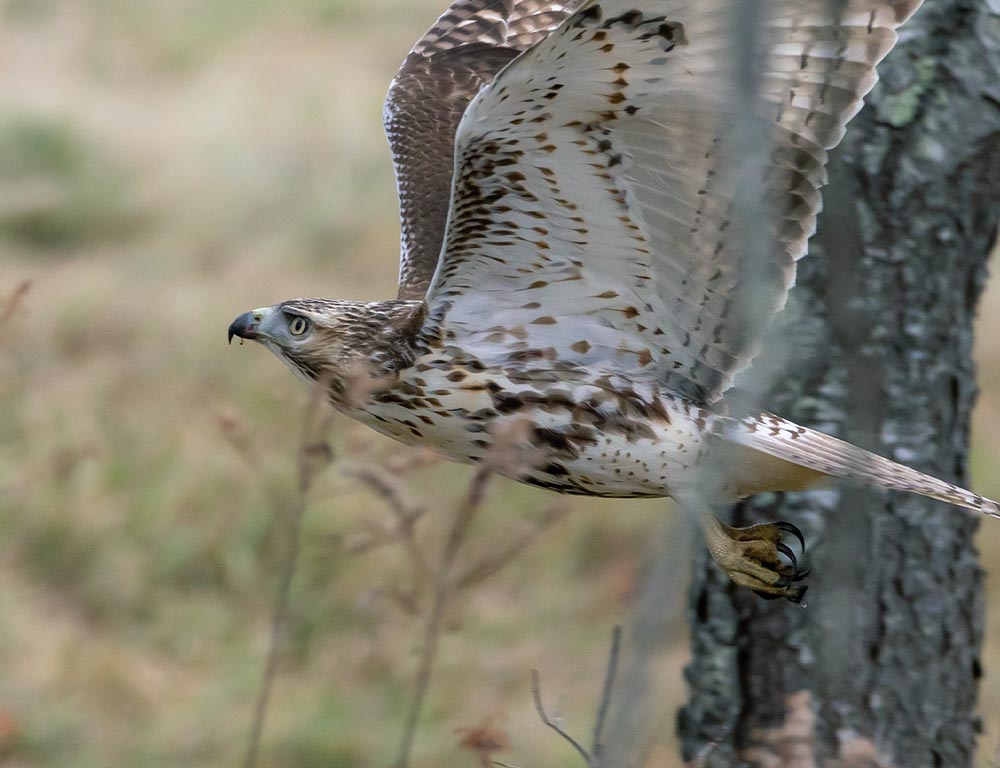
- Scientific name: Buteo jamaicensis
- Life span: 10-21 years
- Size: 18-26 inches
- Weight: 2-4 pounds
- Food: Small mammals, birds, reptiles
- Wingspan: 43-57 inches
- Status: Common and widespread
The Red-Tailed Hawk, one of the most iconic raptors in North America, is prevalent in Michigan. With a lifespan of 10-21 years, it has a size ranging from 18-26 inches and weighs 2-4 pounds.
Its distinctive red tail feathers become more prominent as the bird matures. The wingspan of a Red-Tailed Hawk spans from 43-57 inches, allowing for efficient soaring and gliding.
These hawks have a diverse diet, including small mammals, birds, and reptiles. Their adaptability to various habitats, from open fields to wooded areas, contributes to their common and widespread status.
Red-tailed hawks are known for their soaring flight and impressive hunting techniques, making them a prominent and integral part of Michigan’s birdlife.
6. Cooper’s Hawk
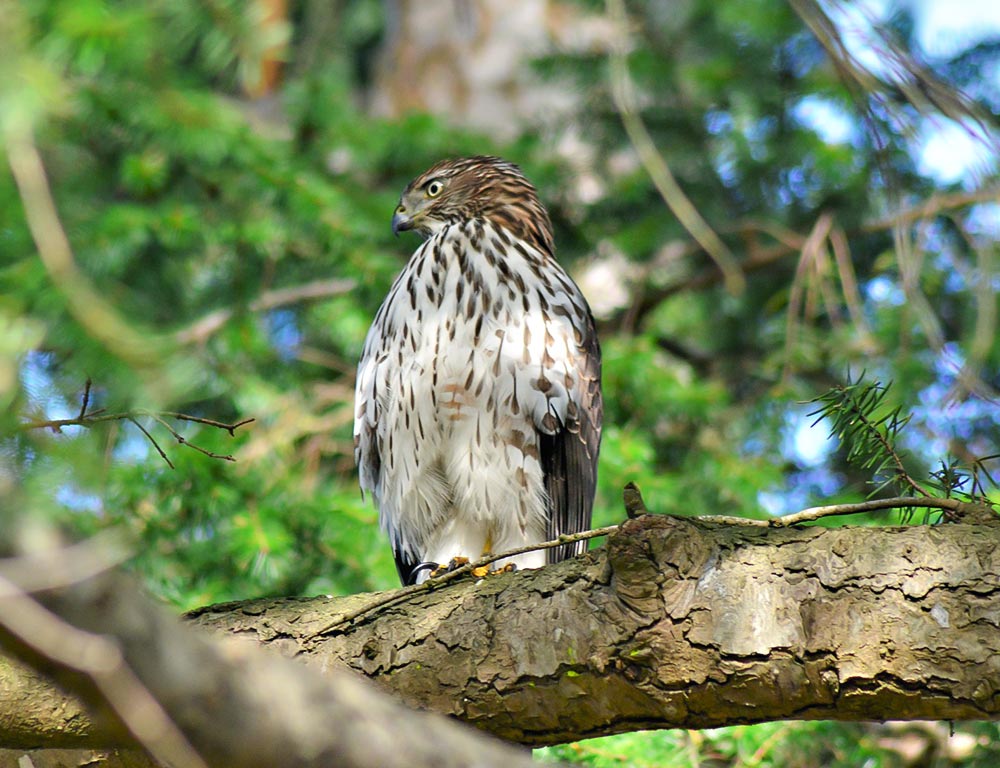
- Scientific name: Accipiter cooperii
- Life span: 7 years (average)
- Size: 14-20 inches
- Weight: 0.5-1.5 pounds
- Food: Birds, small mammals
- Wingspan: 24-35 inches
- Status: Common and widespread
The Cooper’s Hawk is a medium-sized hawk found in Michigan, recognized for its slender build and long tail.
With an average lifespan of 7 years, it measures between 14-20 inches and weighs 0.5-1.5 pounds. The wingspan ranges from 24-35 inches.
Cooper’s Hawks are adept at capturing birds and small mammals in flight. Their adaptability to urban and suburban environments contributes to their common and widespread status.
These hawks are known for their agile flight and quick maneuvering through dense vegetation, making them skilled hunters in various habitats.
Cooper’s Hawks play a vital role in controlling bird populations, showcasing Michigan’s dynamic and intriguing lifestyle.
7. Rough-legged Hawk
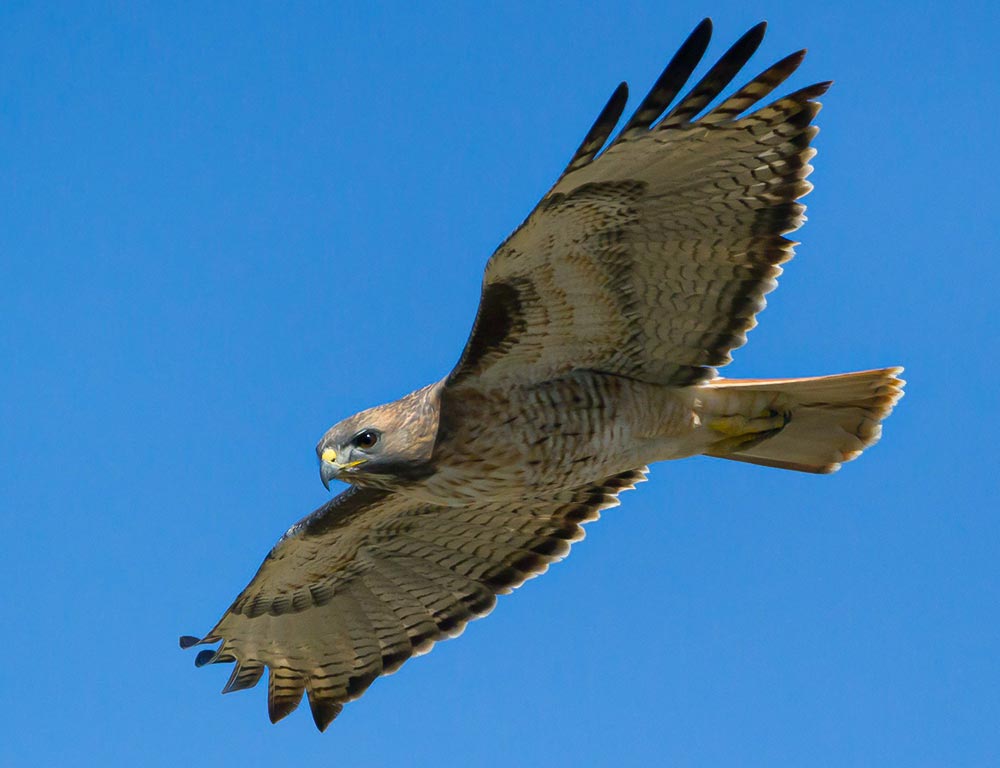
- Scientific name: Buteo lagopus
- Life span: 10 years (average)
- Size: 18-24 inches
- Weight: 1.5-3.5 pounds
- Food: Small mammals, birds
- Wingspan: 52-54 inches
- Status: Generally stable, migratory
The Rough-legged Hawk, named for its feathered legs, is a winter visitor to Michigan. With an average lifespan of 10 years, it measures between 18 and 24 inches and weighs 1.5 to 3.5 pounds, boasting a wingspan of 52 to 54 inches.
These hawks primarily feed on small mammals and birds, and their presence in Michigan is often tied to prey availability during winter. Rough-legged Hawks are known for their habit of hovering over open fields while hunting.
Their migratory behavior adds an element of seasonal movement to their lifestyle in Michigan, making them a fascinating species to observe during the colder months.
8. Northern Goshawk
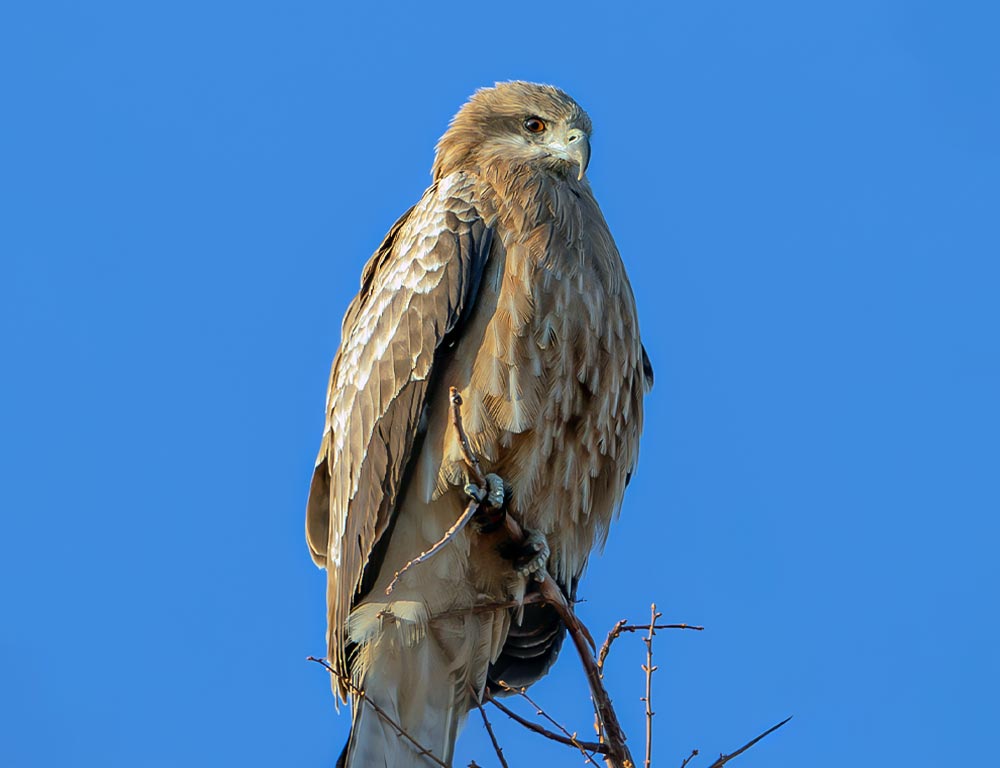
- Scientific name: Accipiter gentilis
- Life span: 8-10 years
- Size: 20-27 inches
- Weight: 2-4 pounds
- Food: Birds, mammals
- Wingspan: 40-46 inches
- Status: Generally stable, with some regional declines
The Northern Goshawk, a powerful and secretive hawk, inhabits the forests of Michigan. With a lifespan of 8-10 years, it measures between 20-27 inches and weighs 2-4 pounds.
The wingspan ranges from 40-46 inches. Northern Goshawks primarily feed on birds and mammals, showcasing a robust and opportunistic hunting style.
While their overall status is generally stable, some regional populations may face declines due to habitat loss and other environmental factors.
Known for their agile flight through dense vegetation, Northern Goshawks exhibit a stealthy and elusive lifestyle in Michigan’s woodlands, contributing to the region’s biodiversity.
Where Are the Best Places to Spot Hawks in Michigan?
Go abroad on a thrilling journey to witness the majestic hawks of Michigan in their natural habitats. Michigan offers a rich tapestry of landscapes for avid birdwatchers, from dense woodlands to open fields.
Explore the best places to spot these magnificent raptors and immerse yourself in the beauty of their flights and hunting prowess.
Pointe Mouillee State Game Area
Nestled along the shores of Lake Erie, this expansive wetland area attracts a variety of hawks, including the Red-Shouldered Hawk.
The diverse ecosystem provides ample opportunities to observe these birds in their natural element.
Huron-Manistee National Forests
Encompassing vast stretches of forested land, the Huron-Manistee National Forests are home to the Broad-Winged Hawk.
Traverse the wooded trails and keep a keen eye on these soaring hunters amidst the towering trees.
Sleeping Bear Dunes National Lakeshore
Overlooking Lake Michigan, the dunes and forests of this national lakeshore attract the Northern Harrier.
Witness their unique hunting behavior over the open fields and marshes, creating a spectacle against the stunning backdrop of the lakeshore.
Isle Royale National Park
For a more remote hawk-watching experience, venture to Isle Royale National Park.
Here, the Northern Goshawk thrives in the isolated wilderness, allowing birdwatchers to observe these elusive predators in their untouched habitat.
Kensington Metropark
Located near Detroit, Kensington Metropark provides an urban oasis for bird enthusiasts.
The mix of woodlands and open spaces attracts various hawk species, including the Cooper’s Hawk. Explore the park’s trails and witness the agility of these hunters in a suburban setting.
Whitefish Point Bird Observatory
Positioned along Lake Superior, Whitefish Point is a renowned migration hotspot. During the fall migration, witness the spectacle of raptors, including the Rough-legged Hawk, as they traverse the expansive Great Lakes region.
The observatory offers an ideal vantage point for observing these magnificent birds in flight.
Jump on an adventure across Michigan’s diverse landscapes and discover the prime locations where these remarkable hawks showcase their prowess and contribute to the state’s vibrant birdwatching scene.
Wrapping Up
In the skies above Michigan, hawks unveil a captivating saga of adaptability, prowess, and ecological significance.
From the urban landscapes to the pristine wilderness, these raptors showcase a tapestry of behaviors, from territorial displays to breathtaking migrations.
The woodlands echo with their calls, and the open fields witness their agile hunts. As sentinels of the ecosystem, hawks in Michigan exemplify nature’s intricate balance, playing vital roles in controlling prey populations.
The diverse landscapes of Michigan provide a perfect stage for the intricate performances of species like the Cooper’s Hawk, Red-Tailed Hawk, and Northern Goshawk.
Observing their courtship displays, understanding their migratory patterns, and witnessing their predatory excellence adds a layer of appreciation for the avian wonders gracing the Great Lakes State. Thank you very much.